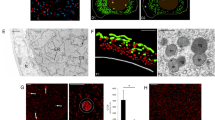Abstract
THE mitochondria almost invariably form an essential component of the motile spermatozoa in the invertebrate1. The possible exceptions, such as the spermatozoon of dragon fly2, need re-investigation in the light of fresh reports on Lepisma3,4. The mitochondria form a sheath around the axial filament, covering varying lengths of the flagellate spermatozoon, normally behind the nucleus; the anterior end of the nucleus being occupied by the acrosome. Exceptions to this rule are certain forms reported to have atypical spermatozoa1; the most commonly cited examples being the spermatozoa of Lepisma1,3–5 and Cicindela5,6. In both these cases the centrosome moves forward to the anterior end of the nucleus dragging with it the axial filament having an extension of the mitochondrial sheath. In Lepisma the polarity of the nucleus is completely reversed, consequently the acrosome remains in the neck region and the centrosome heads the spermatozoon. These observations on the atypical flagellate spermatozoa have often been questioned as exemplified by a recent controversy on thysonuran spermatozoa4,7–10.
This is a preview of subscription content, access via your institution
Access options
Subscribe to this journal
Receive 51 print issues and online access
$199.00 per year
only $3.90 per issue
Buy this article
- Purchase on Springer Link
- Instant access to full article PDF
Prices may be subject to local taxes which are calculated during checkout
Similar content being viewed by others
References
Nath, V., Res. Bull. Panjab Univ., Old Ser., 95, 1 (1957).
Nath, V., and Rishi, R., Res. Bull. Panjab Univ., Old Ser., 31, 67 (1953).
Nath, V., and Bhatia, C. L., Res. Bull. Panjab Univ., Old Ser., 27, 33 (1953).
Nath, V., Gupta, B. L., and Mittal, L. C., Nature, 186, 899 (1960).
Bowen, R. H., J. Morph., 39, 351 (1924).
Nath, V., Gupta, B. L., and Mehta, S., Res. Bull. Panjab Univ., Old Ser., 104, 251 (1957).
Gatenby, J. B., and Mathur, R. S., Nature, 185, 861 (1960); 186, 900 (1960).
Mathur, R. S., J. Roy. Micro. Soc., 80, 9 (1961).
Bawa, S. R., J. Morph., 107, 141 (1960).
Nath, V., Gupta, B. L., and Mittal, L. C., Res. Bull. Panjab Univ. (in the press).
Brachet, J., Biochemical Cytology (Academic Press, New York, 1957).
Bourne, G. H., Lab. Invest., 8, 431 (1959).
Sharma, G. P., and Gupta, B. L., Res. Bull. Panjab Univ., Old Ser., 84, 5 (1956).
Pearson, B., and Defendi, V., Cancer Res., 15, 593 (1955). Pearson, B., J. Histochem. Cytochem., 6, 112 (1956).
Sharma, G. P., Proc. Nat. Inst. Sci. (India), 10, 305 (1944).
Rothschild, Lord, Quart. J. Micro. Sci., 102, 239 (1961).
Author information
Authors and Affiliations
Rights and permissions
About this article
Cite this article
GUPTA, B., KAMBOJ, V. Histochemical Localization of Succinic Dehydrogenase Activity in the Mitochondria of some Invertebrate Spermatozoa. Nature 193, 788–789 (1962). https://doi.org/10.1038/193788a0
Issue Date:
DOI: https://doi.org/10.1038/193788a0
Comments
By submitting a comment you agree to abide by our Terms and Community Guidelines. If you find something abusive or that does not comply with our terms or guidelines please flag it as inappropriate.



